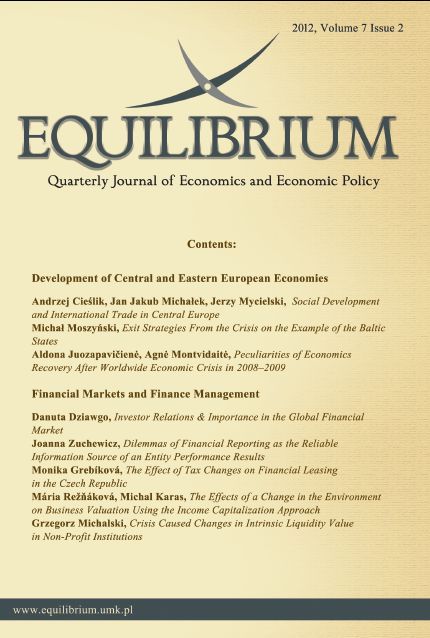Exit Strategies From the Crisis on the Example of the Baltic States
DOI:
https://doi.org/10.12775/EQUIL.2012.009Keywords:
financial crisis, exit strategies, macroeconomic policy, fixed exchange rateAbstract
The aim of this paper is to analyze the macroeconomic policy of the Baltic states in response to the financial crisis of the years 2007-2010. The considerations are based on the thesis that the general direction of the macroeconomic policy chosen by the analyzed countries is correct. The consistent maintaining of a fixed exchange rate during the crisis aroused much controversy and was criticized in the literature. In the study, particular attention was paid to the issues of exchange rate, which has constituted the key element of the policy, both in the initial period of transformation, as well as in the times of recession. The first part of the study concentrates on the specificities of small open economies of the Baltic countries and on the determinants of their monetary and exchange rate policy. Subsequently, the economic situation of the Baltic republics in the face of the crisis was characterized, indicating the main factors increasing their vulnerability to economic shocks. The next subject of the analysis was the macroeconomic policies in response to the deep recession. The considerations were intended to assess the validity of maintaining a fixed exchange rate policy as a core element of an anti-crisis strategy. The methods used in solving the scientific problem were the critical literature studies and the analysis of macroeconomic indicators.
Downloads
References
Bank of International Settlements (2011), Consolidated banking statistics, Table 9B: Consolidated foreign claims of reporting banks, www.bis.org.
Becker T. (2009), IMF and Latvia ? why going for third best?, Stockholm Institute of Transition Economics (SITE) at the Stockholm School of Economics, www.hhs.se/site.
The Council Of The European Union (2009), Council opinion of 10 March 2009 on the updated convergence programme of Lithuania, 2008-2011 (2009/C 70/02).
Eurobarometr (2010), Flash EB No 296 ? Introduction of the euro in the new Member States.
European Central Bank (2011) Statistical Pocket Book February 2011.
European Commission (2010a), General Government Data, Autumn 2010.
European Commission (2010b), European Economy Autumn 2010.
European Commission (2008), Convergence Report 2008, Brussels.
European Commission (2009), Recommendation for a Council decision granting mutual assistance for Latvia, 52009PC0004(01), Brussels.
Feldmann, M. (2008), Baltic States: When Stability Culture Is Not Enough, in: K. Dyson, Euro at 10, Europeization, Power and Convergence, Oxford University Press, Oxford, New York.
Gurtner, F. (2004), Why Did Argentina?s Currency Board Collapse?, ?The World Economy?, Vol. 27, No. 5.
International Monetary Fund (1998), World Economic Outlook, Washington.
International Monetary Fund (2008), World Economic Outlook Database, April.
Narodowy Bank Polski, Analiza sytuacji gospodarczej w krajach EŚW, maj 2009, Instytut Ekonomiczny, Biuro Gospodarki Światowej i Europejskiej Integracji Gospodarczej.
Reinhard, C.M, Rogoff, K.S, Dieses Mal ist alles anders, FinanzBuch Verlag, München 2010.
Sławiński, A. (2007), Znaczenie czynników ryzyka towarzyszących wchodzeniu Polski do ERM2 i do strefy euro, referat na Kongres Ekonomistów Polskich, www.nbp.pl/publikacje/wyklady/plslawinski_euro.pdf.
Statistics Estonia, Main Indicators, http://www.stat.ee/main-indicators (as of 10.05.2011).
The World bank (2010), EU-10 Regular Economic Report, November.
The World Bank (2009), EU10 Regular Economic Report: From Stabilization to Recovery.






